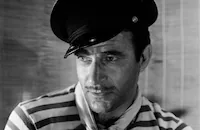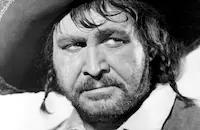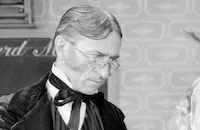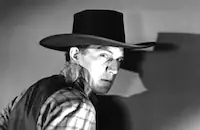The Dude Goes West

Brief Synopsis
Cast & Crew
Kurt Neumann
Eddie Albert
Gale Storm
James Gleason
Gilbert Roland
Binnie Barnes
Film Details
Technical Specs

Synopsis
In 1876, Daniel Bone abandons his father's gunsmith business in Brooklyn and heads West to set up shop in Arsenic City, Nevada, site of a gold rush. On board the train west, Dan, an avid reader, learns western history and teaches himself Indian sign language. After changing trains in Kansas City, Dan meets Liza Crockett, who is also going to Arsenic City, and the Pecos Kid. During the onboard Sunday services, Dan sees Pecos steal Liza's purse and, after a brief scuffle with him on the railroad car platform, pushes him off the train, relieving him of his gun while simultaneously saving the purse. However, Liza thinks Dan has stolen her purse. Meanwhile, Pecos, who had planned to leave the train at that point anyway, is met by his cohort Beetle and swears to him that he will get even with Dan, the "dude." In Carson City, Dan learns that the stagecoach to Arsenic City is fully booked for weeks ahead, and buys an old bakery wagon, a horse, Stetson and boots. At the Red Dog Saloon, Dan observes gold miner Sam Briggs being cheated in a card game and intervenes on his behalf. Later, Dan shows Sam a gun made by his father, which looks like a pipe. Sam joins Dan on the trip to Arsenic City and along the way, Sam tells Dan that he knew Liza's father, a prospector who struck a motherlode but was killed in an ambush without revealing the location of the strike. Meanwhile in Arsenic City, Texas Jack Barton and his gang hold up the bank and, during their getaway, Jack is shot in the leg. Dan finds him in the desert, and Jack claims to have shot himself in the leg. When Dan shows Jack the gun he took from Pecos, he earns Jack's respect. Jack tells him that Pecos is the best shot in Nevada after him, but after Dan proves that he is a far better shot than Jack, Jack asks him to join his gang. When Dan declines, Jack slugs him and takes his horse and wagon, leaving him to walk to Arsenic City. Liza happens along in a buckboard and reluctantly agrees to take him into town. On the way, they are attacked and taken prisoner by Paiute Indians. From his reading, Dan remembers that the Paiutes are superstitious and, by way of some basic magic and his knowledge of sign language, is able to trick the chief, Running Wolf, and becomes his blood brother. After Dan tells the chief that Liza is his squaw, they stay with the tribe for several days. Eventually Dan and Liza reach Arsenic City, where Dan finds his wagon with a note of apology from Jack and learns that Jack has a $5,000 reward on his head. Liza, who did not appreciate the hard labor she had to perform as Dan's "squaw," is anxious to part company with him. She goes to see lawyer Horace Hotchkiss, who claims to have been her father's best friend and is particularly interested to learn that she may have a map to the gold strike. Hotchkiss is in cahoots with Kiki Kelly, a saloonkeeper, and with Pecos, who killed Liza's father. Pecos was supposed to have stolen the map from Liza while on the train. In the saloon, Pecos challenges Dan to a gunfight, which Dan wins by shooting the gun out of his hand. Outside, Dan discovers two of Pecos's henchmen trying to rob Liza. When he shoots them dead, Liza faints and Dan takes her to her hotel room, where he discovers the map, memorizes it, then burns it. Liza now has to trust Dan as he is the only person who knows the location of the mine. Pecos sets a trap for his rival, Jack, and is about to have him lynched when Dan and Sam stop the proceedings. They are able to free Jack, but Kiki shoots and kills Sam. Later, Dan enlists the Indians' help in beginning mining operations and arranges for two Indians to kidnap Liza and bring her to the mine, where he shows her a large quantity of gold. On their way back into Arsenic City, Dan and Liza, who realize they are in love, are stopped by Pecos and Kiki, who demand to know the location of the mine. Kiki and Pecos, in turn, are held up by Texas Jack, who shoots Kiki. After Pecos shoots Jack, Dan shoots Pecos with his pipe gun. Dan and Liza are then pursued by Pecos' men, but Dan's Indian friends ride to their rescue. Running Wolf escorts them back into town and Liza officially becomes Dan's "squaw."

Director
Kurt Neumann
Cast

Eddie Albert
Gale Storm

James Gleason

Gilbert Roland

Binnie Barnes

Barton Maclane
Harry Hayden
Catherine Doucet
Sarah Padden

Douglas Fowley

Olin Howlin
Francis Pierlot
Chief Yowlachie
Edward Gargan
Tom Fadden
Si Jenks

George Meeker
Frank Yaconelli
Charles Williams

Tom Tyler
Lee "lasses" White
Ben Weldon
Iron Eyes Cody
Dick Elliott
Crew
Daniel Decatur Emmett
Arthur Gardner
Jo Graham
Carla Hadley
Frank S. Heath
Richard Heermance
Ernest R. Hickson
Edward Kay
Frank King
Herman King
Maurice King
Madison Lacey
Tom Lambert
Emile Lavigne
Jules Levy
Harry Lewis
Mary Loos
Lorraine Maclean
Bob Martin
Ray Mercer
Sidney Moore
Richard Sale
Karl Struss
Dimitri Tiomkin
Herman E. Webber
Gordon Wiles
William Ziegler

Film Details
Technical Specs

Articles
Dude Goes West -
By Richard Harland Smith

Dude Goes West -
Quotes
Trivia
Notes
This film's working title was The Tenderfoot. Although onscreen credits list Richard Heermance as editor, Hollywood Reporter production charts and copyright records list William Zeigler. According to August 1947 Hollywood Reporter news items, background shots for The Tenderfoot were made at the Bowie (Texas) Rodeo and a cattle stampede was staged near Winemucca, NV. None of this footage appears in the released film, however. A November 20, 1947 Los Angeles Times news item includes Milburn Stone in the cast, but he was not seen in the viewed print.














